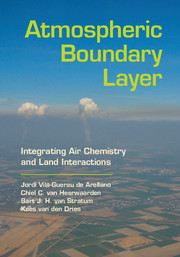Book contents
- Frontmatter
- Contents
- CLASS Software
- Preface
- Acknowledgments
- Part I The Land-Atmospheric Boundary Layer System
- Part II The Uncoupled System
- Part III The Coupled System
- 9 Atmosphere-Vegetation-Soil Interaction
- 10 Numerical Experiments: Atmosphere-Vegetation-Soil Interaction
- 11 A Dynamic Representation of Carbon Dioxide Exchange from the Vegetation and Soil
- 12 Sensitivity of the Atmosphere-Vegetation-Soil System to Climate Perturbations
- 13 Case Studies of More Complex Situations
- Part IV Processes Related to Boundary Layer Clouds
- Part V User's Guide: CLASS Modules and Variables
- Appendices
- Bibliography
- Index
13 - Case Studies of More Complex Situations
from Part III - The Coupled System
Published online by Cambridge University Press: 05 July 2015
- Frontmatter
- Contents
- CLASS Software
- Preface
- Acknowledgments
- Part I The Land-Atmospheric Boundary Layer System
- Part II The Uncoupled System
- Part III The Coupled System
- 9 Atmosphere-Vegetation-Soil Interaction
- 10 Numerical Experiments: Atmosphere-Vegetation-Soil Interaction
- 11 A Dynamic Representation of Carbon Dioxide Exchange from the Vegetation and Soil
- 12 Sensitivity of the Atmosphere-Vegetation-Soil System to Climate Perturbations
- 13 Case Studies of More Complex Situations
- Part IV Processes Related to Boundary Layer Clouds
- Part V User's Guide: CLASS Modules and Variables
- Appendices
- Bibliography
- Index
Summary
The interactions of the land-atmosphere system, including the presence of boundary layer clouds, become more complex and challenging when we study the relationships among more than two components of the system. So far, we have studied the interaction between surface processes and boundary layer dynamics without taking the influence of atmospheric flows driven by spatial scales larger than that of ABL dynamics into account. The only exceptions are the role played by subsiding motions (see Chapter 4) or the sensitivity of the soil-vegetation-atmosphere system to climate perturbations (see Chapter 12). The atmosphere is a multi-scale flow, and for that reason it is important to determine how processes and phenomena occurring on larger spatial and temporal scales, such as sea breezes or droughts, influence the soil-vegetation-atmosphere system. This chapter provides a series of examples to study how the surface energy balance, including the net ecosystem exchange (NEE), responds to and interacts with larger-scale atmospheric flows, and the influence it has on the diurnal variability of temperature, specific moisture, and carbon dioxide, and the onset and intensity of cloud. We also investigate how our modelling system can be employed to study the land-atmospheric system beyond diurnal time-scales. This enables us to study the effect of drought on air quality and how air pollutant concentrations rise in events that are typically characterized by high pollution levels that may last for four or five days. Note that these case studies provide a first idea of the coupling between large-scale phenomena and land-atmosphere interaction, and as such they can be a complement to the interpretation of more complex atmospheric weather and air quality models.
The possibilities offered by the model system are many, and we therefore restrict ourselves to a few relevant examples in order to enable the reader to extend and improve his or her understanding obtained in previous chapters. Note, however, that fully implementing properly the physical representations may require changes in the CLASS modelling system and therefore modifications of the code. However, all the experiments proposed here can be carried out using the CLASS interface.
- Type
- Chapter
- Information
- Atmospheric Boundary LayerIntegrating Air Chemistry and Land Interactions, pp. 156 - 176Publisher: Cambridge University PressPrint publication year: 2015



